I disagree.
Points to consider:
1. Grid power is already under someone else's control.
2. Personal power is always under your own control if not connected to the grid.
3. If you want to connect to someone else's stuff, then you have to play by their rules. If they want to connect to your stuff, they have to play by your rules. Unfortunately, the former is far more common than the later.
The problem I see, and I'm sure the marketplace will come up with a solution sooner or later, is when your personal power is capable of producing more than it is being allowed to produce by being under someone else's control. For example, a nice cool sunny day is allowing your 10kW solar array to produce a full 10kW, but since everyone else's array is also pushing max power, they curtail everyone's production down to the 6 kW range. So your investment isn't returning all its worth and you are harmed by that.
I foresee grid tied hybrid battery inverters capable of matching grid frequency while separately regulating your own array and using the extra juice its not allowed to pump into the grid to charge batteries or dump the excess energy to do something else.
Maybe another 10 years out. Of course, we already have zero export inverters.







